Physical Address
304 North Cardinal St.
Dorchester Center, MA 02124
It has long been recognized that congenital absence of the spleen, or the presence of multiple spleens, is associated with severe congenital malformations of the heart. Some of the most complex forms of congenital cardiac disease are associated with these splenic abnormalities. Prognosis for many patients with these lesions remains poor, even in the modern era of congenital cardiovascular surgery. If progress is to continue in the care of these children, the cardiac abnormalities need to be determined with precision in each case. More importantly, they need to be described in unambiguous fashion to the surgeon attempting correction or palliation. Description of the so-called “splenic syndromes,” however, continues to be the cause of much confusion and controversy. It is now established that cardiac structures are best identified on the basis of their most constant components, following the so-called morphologic method . When considering the atriums, it is the appendage that is most constantly present (see Chapter 1 ). The presence of isomeric atrial appendages is the most accurate feature with which to stratify the patients previously labeled as having “splenic syndromes,” or more recently as having either “situs ambiguous,” or “visceral heterotaxy.” To set the scene for clarification, we begin this account by reviewing some of the historical landmarks in the recognition of the cardiac malformations seen in the syndromes. We then seek to clarify some of the confusing nomenclature that has evolved over the last few decades. We then describe in detail the morphologic and clinical features of these cardiac malformations, taking advantage of our own extensive recent researches, correlating the cardiac features with the findings within the other systems of organs. We then focus attention on the progress made in recent years in the diagnosis and treatment of patients with these complex malformations.
Absence of the spleen is an obvious autopsy finding. It is unlikely to be missed, and was noted as long ago as the 16th century, but very likely as the consequence of tuberculous infection. The earliest recorded examples of congenital absence are probably those appearing in 1826. Multiple spleens occurring as a congenital malformation had been recorded over 30 years previously. These early accounts recognized not only the splenic anomalies, but also the abnormal arrangements of other organs, including the cardiac malformations. Over recent decades, there has been a more systematic analysis of the cardiac and extracardiac malformations seen in patients with congenital splenic anomalies. This has resulted in recognition that the entire bodily arrangement of involved patients differs from both the usual arrangement, or “situs solitus,” and its mirror-imaged variant, typically described as “situs inversus.” It is of note that in his classical description, Ivemark introduced the phrase “asplenia, a teratologic syndrome of visceral symmetry.” Shortly after, Putschar and Mannion, with remarkable prescience, stated: “The relationship of agenesis of the spleen to disturbed development of laterality, however, goes beyond the manifestations of obvious situs inversus. Between the normal situs, which is asymmetrical, and the situs inversus, which is the asymmetrical mirror image of normality, a symmetrical situs sometimes exists, exhibiting symmetrical rightness or leftness on both sides.” It is hard to find any subsequent account that so well expresses the concept of biologic isomerism that is the essence of the “splenic syndromes.”
This fact is the more surprising, since note had been taken not only of isomerism of the right atrial appendages and sinus nodes in patients having absence of the spleen, but also the obvious bilateral left sidedness in patients with multiple spleens. The approach in which the cardiac malformations continue to be grouped under the headings of “asplenia” and “polysplenia” by some, within an overall grouping of “situs ambiguous,” is less than ideal at a time when most centers dealing with congenital cardiac disease use a sequential segmental approach to diagnosis. Such analysis, of necessity, must start with accurate identification of the arrangement of the atrial chambers. When the essence of the malformations is now proven to be isomerism, rather than lateralization, of the atrial appendages, there is nothing ambiguous, or uncertain, concerning the atrial morphology. In terms of the scientific rigor, it is also the case that molecular advances have made it possible to generate knockout mice with unequivocal isomerism of the atrial appendages. We see no reason for continuing to use “situs ambiguous,” even though a definition for the entity was suggested by the international working group dealing with nomenclature. We recognize that isomerism is not uniformly present. Indeed, it is the case that only the thoracic organs show evidence of isomerism. Providing each system of organs is described separately, all questions of ambiguity are removed by accurate description.
Isomerism does impact survival, with greater mortality in those with isomerism when compared to those with similar congenital heart defects but without isomerism. Survival has improved with time in isomerism patients with functionally univentricular circulation and biventricular circulation. Mortality seems to be greatest in the first 3 years of life when all isomerism patients are grouped together. Survival at 10 years of age is 61% and survival at 25 years of age is 35%. If only those in the current era born after 2000 are considered, there is 70% survival at 13 years of age. When the subsets of isomerism are compared, those with left isomerism tend to have better survival until approximately 14 years of age. Survival at 5 years of age is 94% in those with left isomerism and 76% in those with right isomerism, while survival at 10 years of age is 83% in those with left isomerism and 64% in those with right isomerism. As might be expected, those with biventricular circulation have increased survival when compared to those with functionally univentricular circulation. In those with biventricular circulation, survival at 5 and 10 years of age is 89% and 84%, respectively. Obstructed pulmonary venous connection, congenital atrioventricular block, moderate or greater atrioventricular regurgitation, presence of a common atrioventricular junction, pulmonary atresia, and need for extracorporeal membrane oxygenation are all associated with increased mortality in those with isomerism.
Structural isomerism, strictly enantiomerism, is seen when entities are mirror images of each other ( Fig. 26.1 ). In this respect, the usual arrangement of the organs within the body, when compared to its mirror-imaged variant, is an example of biologic enantiomerism ( Fig. 26.2 ). It is now established beyond reasonable doubt that within the heart, when assessed according to the extent of the pectinate muscles relative to the atrioventricular junctions, it is the atrial appendages that show the enantiomeric features. It is, however, only the atrial appendages that are uniformly isomeric. One of the features of isomerism is anomalous venoatrial connections, although the patterns of flow through the anatomically abnormally connected veins can be quasi-usual or quasi–mirror imaged. Emphasis is placed on the appendages simply because the venoatrial connections, along with vestibular morphology and septal structure, are all variable. For example, the pulmonary veins may be connected to the morphologically right atrium, or to an extracardiac site. The atrioventricular junction may be absent, as in tricuspid or mitral atresia. Although the atrial septum has typical morphologically right and morphologically left sides, they are not always there. These variable features, following the precepts established by the so-called morphologic method, cannot be used as reliable indicators of morphologically rightness or leftness. Instead, the heart with right isomerism will be characterized by the presence of appendages each having the morphology of the normal right appendage. The uniformly characteristic feature of such rightness is the extent of the pectinate muscles around the atrioventricular junctions, so that they meet at the crux ( Fig. 26.3 ). The external features are usually distinctive, but not always constant with bilateral, morphologically right atrial appendages represented by a blunt, triangular tip and a broad junction with the venous component ( Fig. 26.4 ). This junction is marked by an extensive groove and corresponds internally to a prominent terminal crest. It is the extent of the pectinate muscles that are the universal criterion for morphologically rightness on both sides of the atriums (see Fig. 26.3 ). In contrast, in the heart showing left isomerism, each of the appendages will have the characteristic morphology of the normal left appendage, with the pectinate muscles contained within the tubular appendages, the posterior vestibular areas being smooth on both sides, and directly confluent with the venous components ( Fig. 26.5 ). The tubular appendage of the morphologically left appendage has a narrow or constricted junction with the smooth-walled component of the atrium ( Fig. 26.6 ). The pectinate ridges may extend more laterally than the constricted junction of the appendage, but they are always significantly more limited in their extent than the morphologically right atrium (compare Figs. 26.3 and 26.5 ). Although the major morphologic features of isomeric appendages are to be found internally, the external features are also usually distinctive. The presence of bilateral triangular, as opposed to bilateral tube-like, appendages, however, is not universally present. It is the extent of the pectinate muscles that is the universal criterion for morphologically isomerism of the appendages ( Fig. 26.7 ). The arrangement of the appendages is in most cases harmonious with the arrangement of the thoracic organs. Discordance between pulmonary arrangement and that of the appendages, however, is not uncommon. Such discordance can also be found in patients with normal hearts. For example, in the syndrome of biliary atresia with multiple spleens, it is possible to find bronchial isomerism, but usual atrial arrangement. The morphology of the appendages is the starting point of ongoing sequential analysis, but taking care to note the arrangement of the other systems of organs if discrepancies are identified.
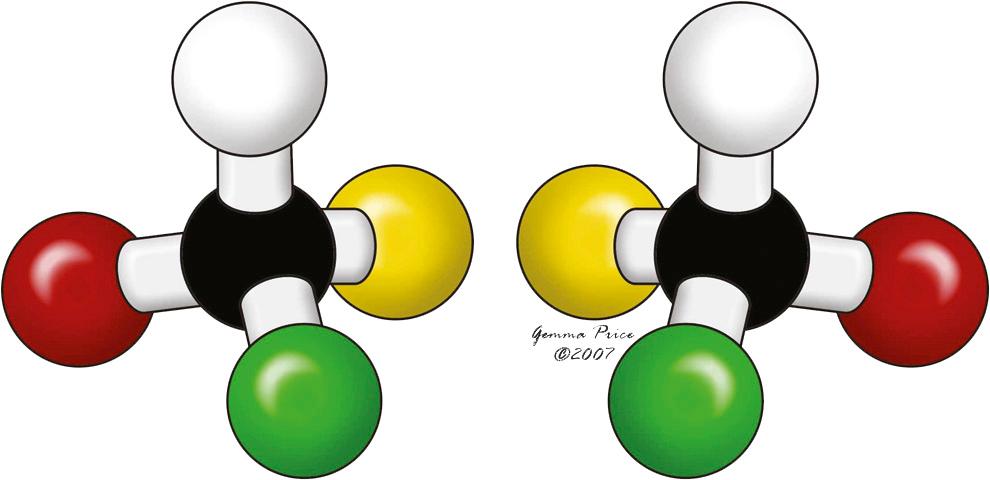
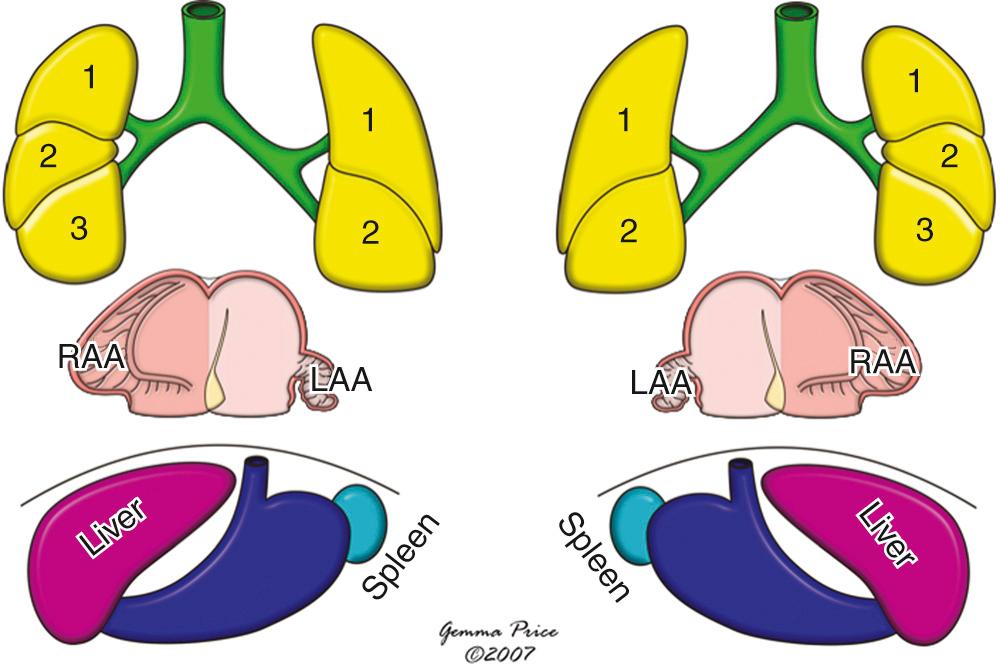
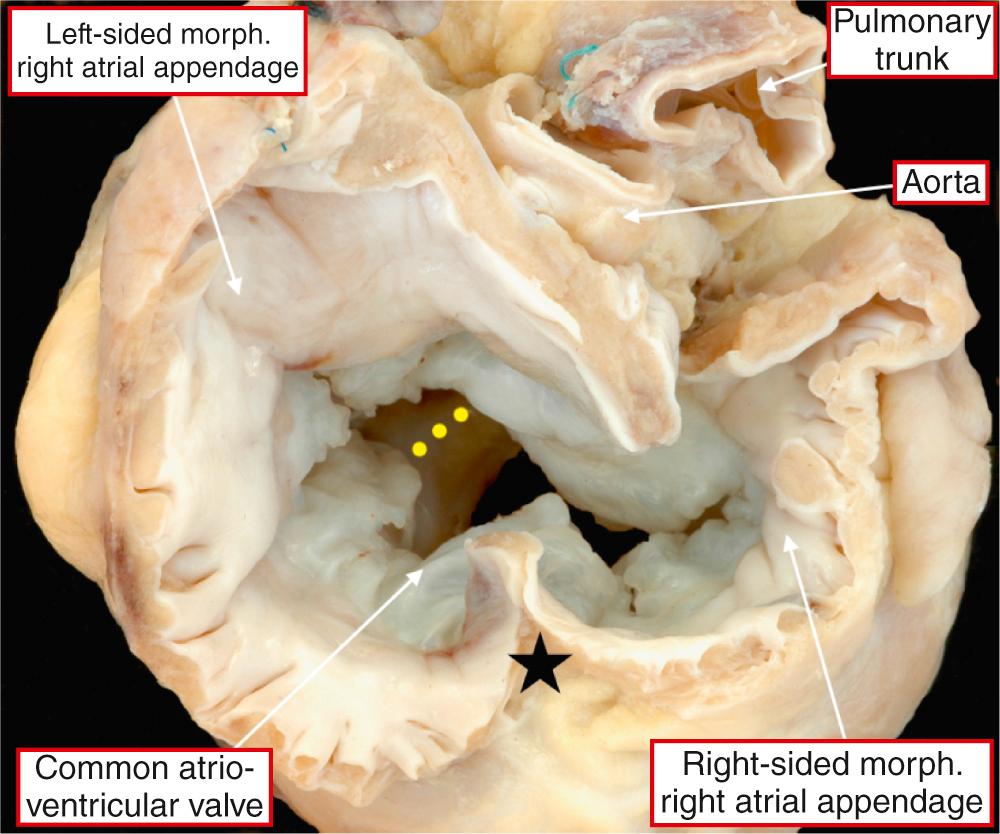
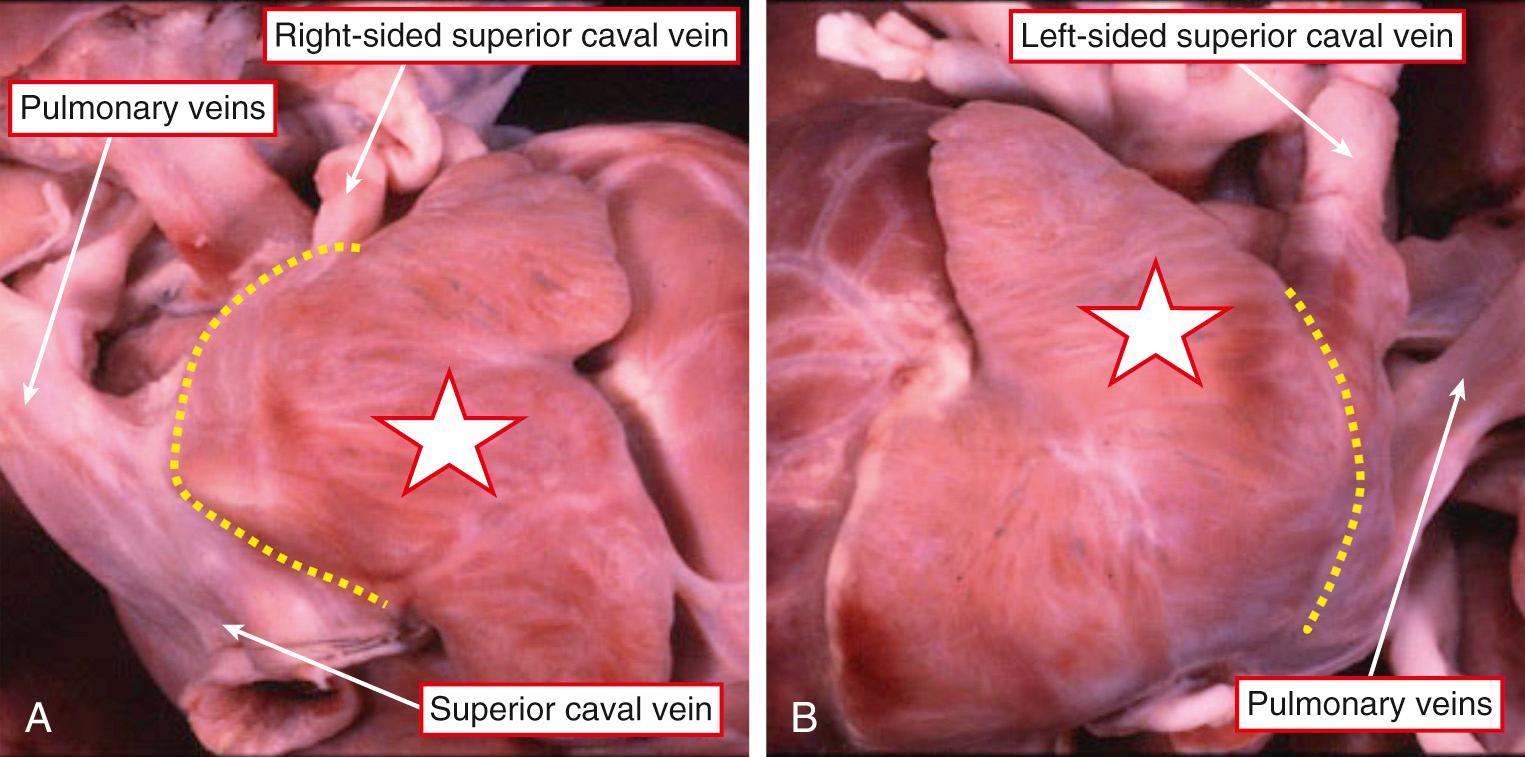
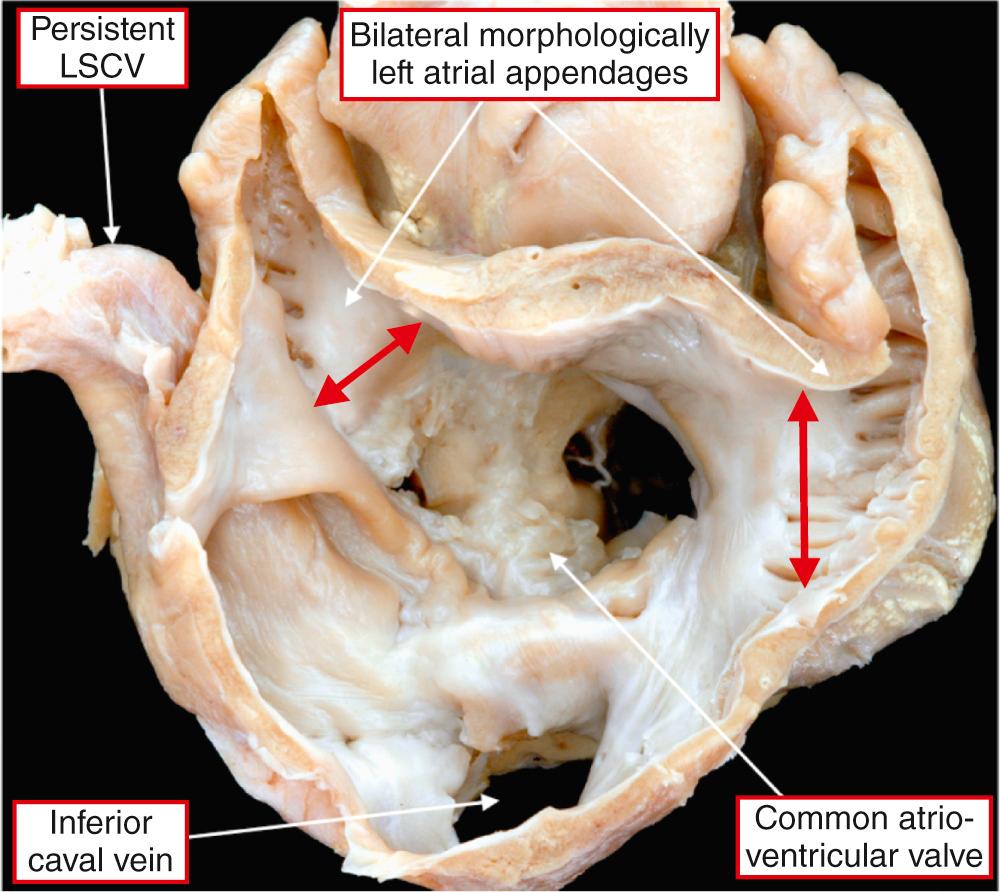
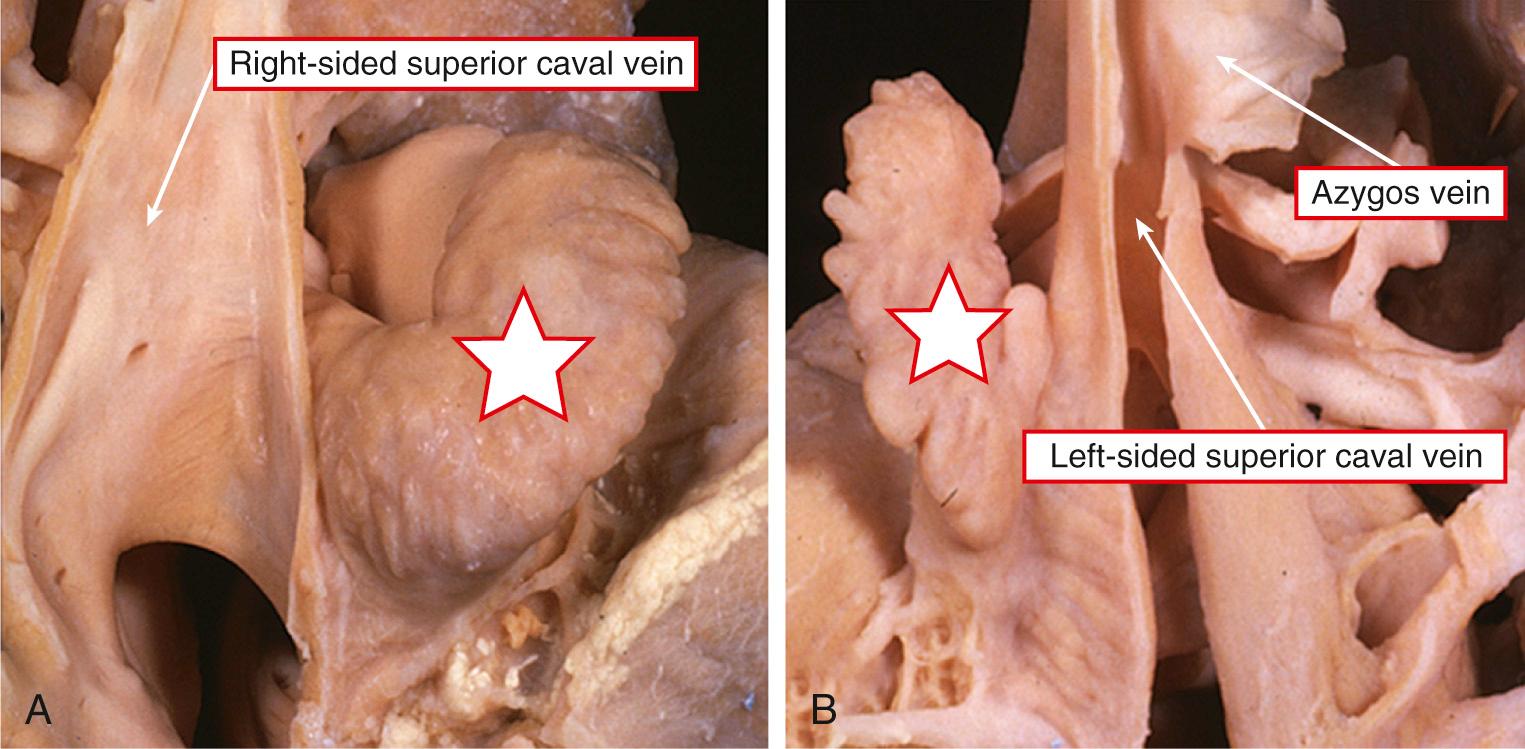
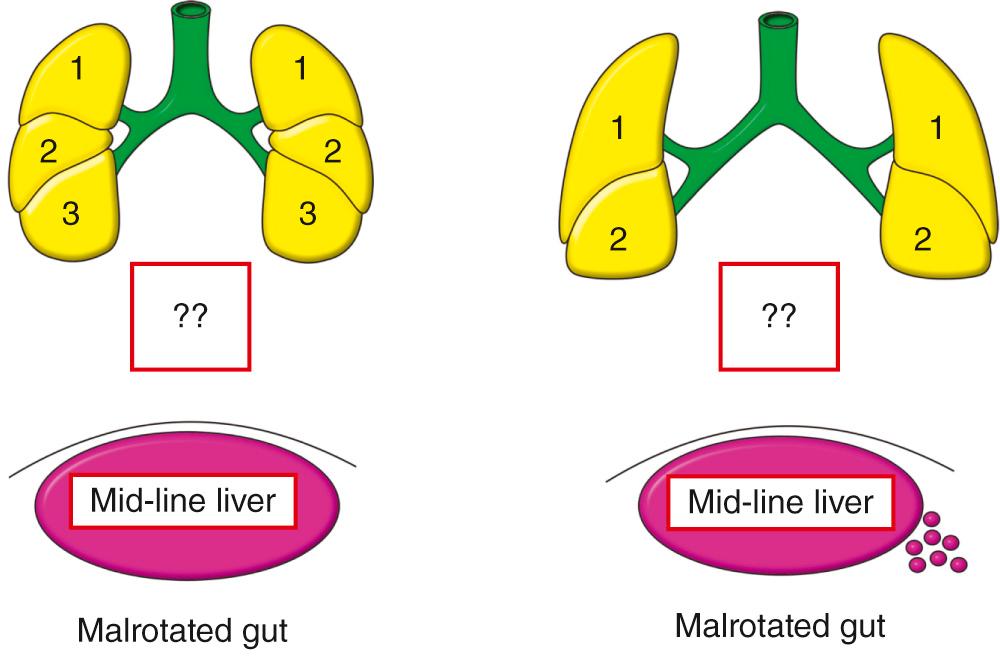
Anomalous venoatrial connections are the rule in patients with isomeric atrial appendages. As already emphasized, some patients with isomeric atrial appendages can have an overall pattern of venous drainage that can be considered usual ( Figs. 26.8 and 26.9 ), or mirror imaged ( Figs. 26.10 and 26.11 ). Even in these patients, however, the venoatrial connections can never be anatomically normal when the appendages are isomeric. In each individual therefore any pattern must be anticipated. Certain features are sufficiently common, nonetheless, usually to permit the differentiation of right and left isomerism. It is the connection of the pulmonary veins that is most reliable in permitting this distinction. In right isomerism, because the pectinate muscles extend to the crux on both sides, the pulmonary venous connections are always anatomically abnormal. Thus, when all the pulmonary veins connect to one of the morphologically right atrial chambers, be the chamber right- or left-sided, the anatomy is always abnormal when compared to the normal connections of the pulmonary veins to the morphologically left atrium. This is because the morphologically left atrium never exhibits pectinate muscles extending to the crux, as is the case when both appendages are morphologically right. In the minority of cases in which the pulmonary veins connect directly to an atrium with a morphologically right appendage, they join the atrial chamber posteriorly ( Fig. 26.12 ). Most usually, when the pulmonary veins do return directly to the heart in the setting of right isomerism, they make their connection via a fibrous confluence, typically opening centrally. Therefore when there are morphologically right appendages bilaterally, the connections of the pulmonary veins will always be anomalous anatomically, even if the atrium receiving the veins is itself left-sided. In about half the patients having isomeric right appendages, such semantic pitfalls do not arise. This is because the pulmonary veins drain exclusively to an extracardiac source. The site of anomalous connection is as varied as when totally anomalous pulmonary venous connection is seen with usual atrial arrangement (see Chapter 29 ). The problems of obstruction within the anomalous pulmonary venous pathway are the same. Indeed, clinical experience suggests that an obstructed supracardiac pathway is more frequent in the setting of right isomerism than in usual arrangement. The other universally constant feature of the venoatrial connections in the presence of isomeric right atrial appendages is absence of the coronary sinus ( Fig. 26.13 ), this channel being a component of the morphologically left atrioventricular junction. When the pectinate muscles extend bilaterally to the crux, there is no room to enclose the sinus within the junctions. Some patients with absence of the spleen may possess a coronary sinus, but this is because not all patients with “asplenia” have isomeric right atrial appendages.

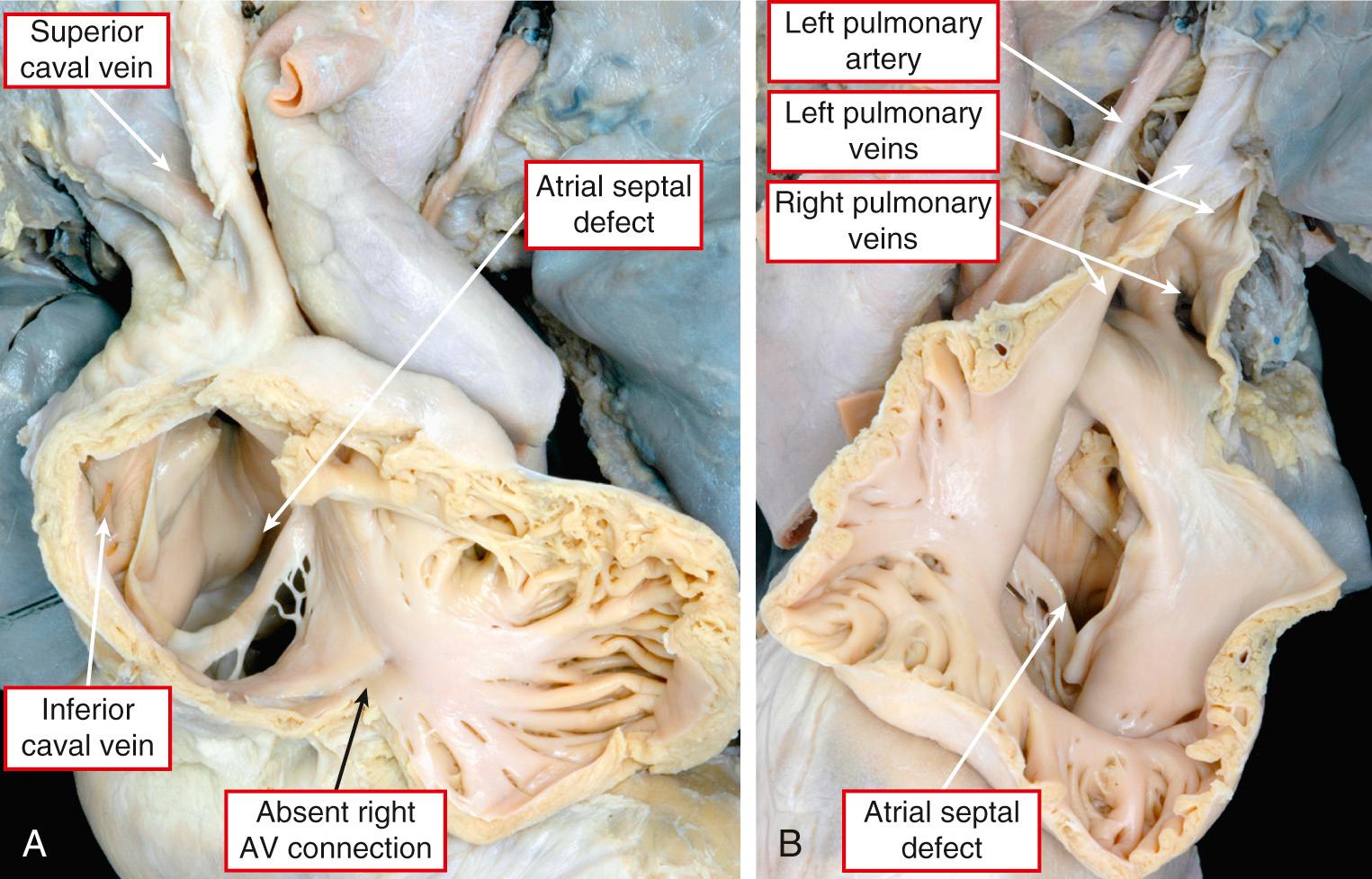
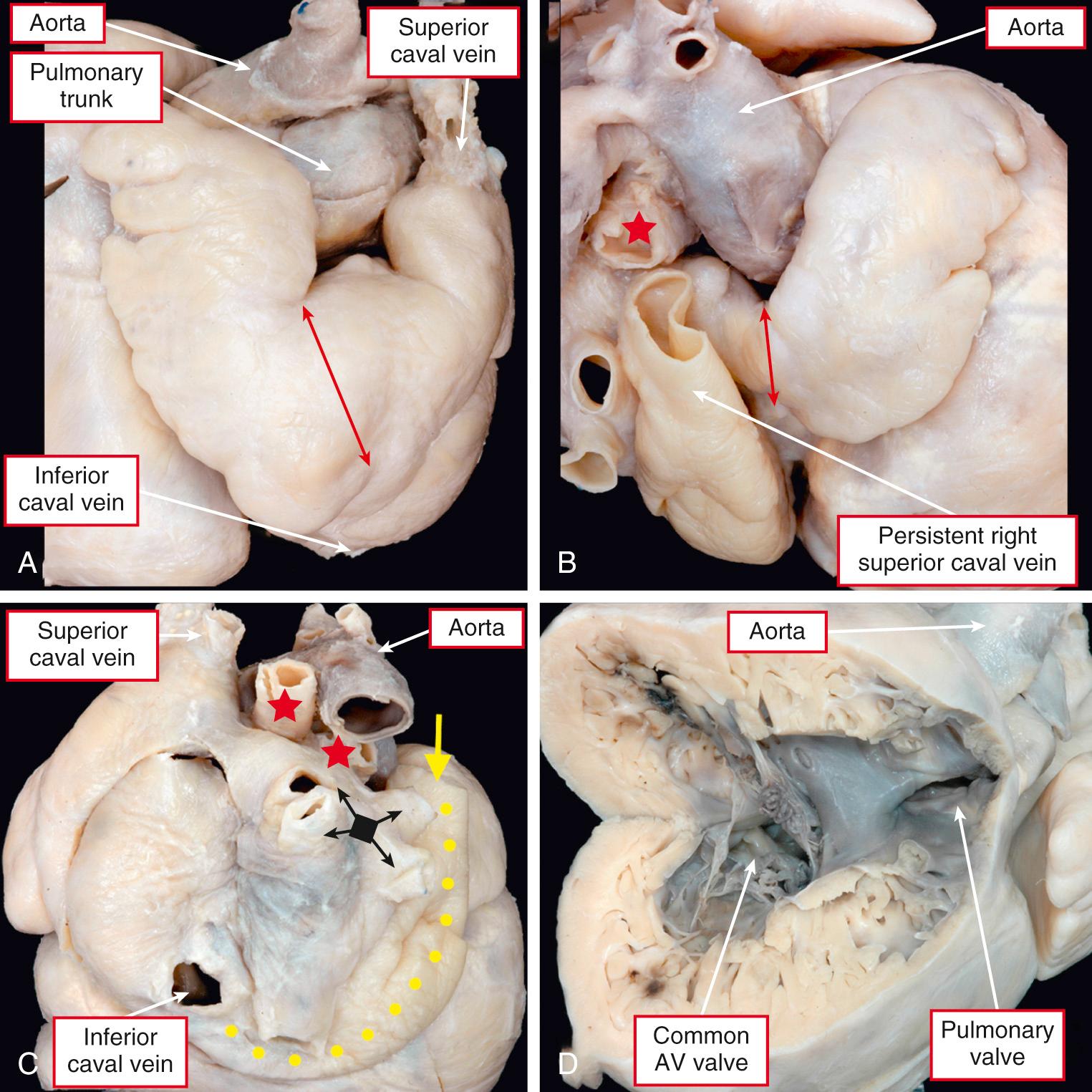
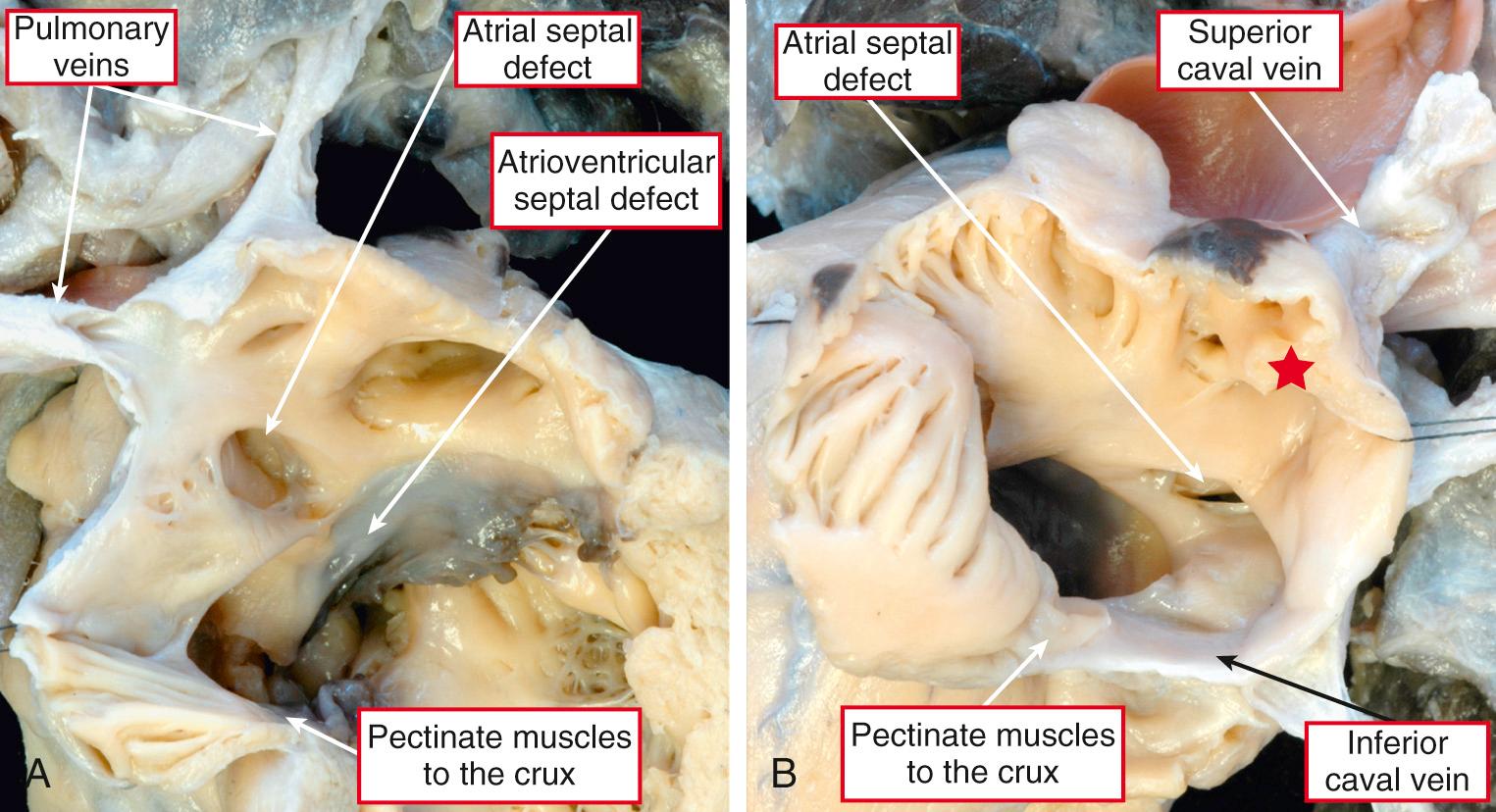
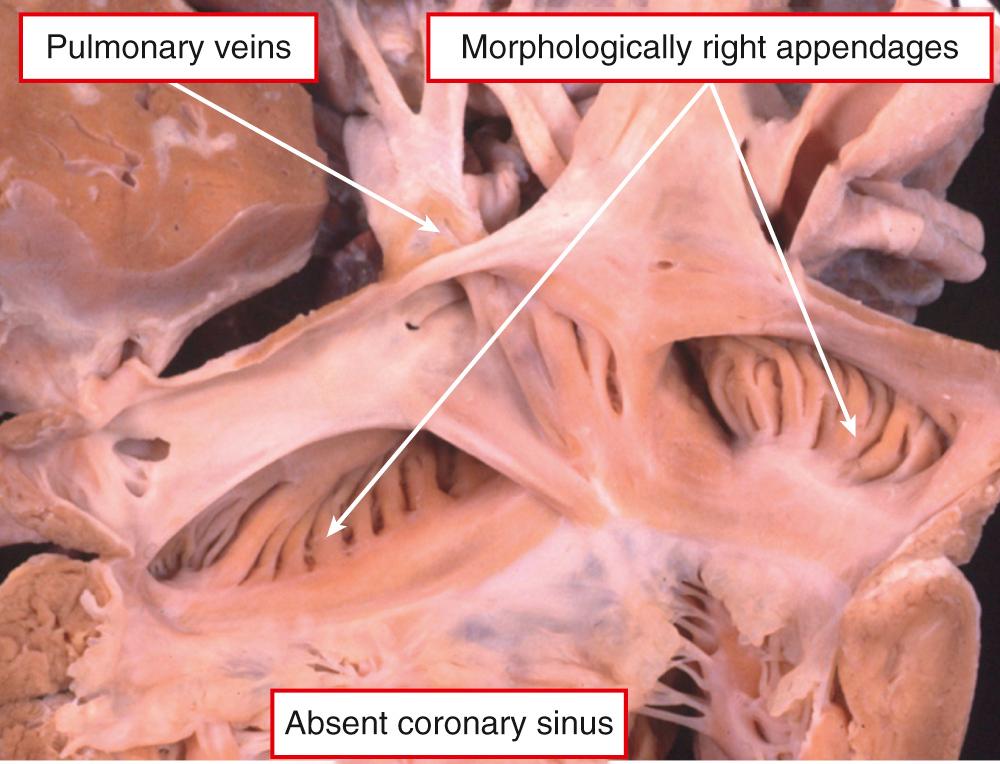
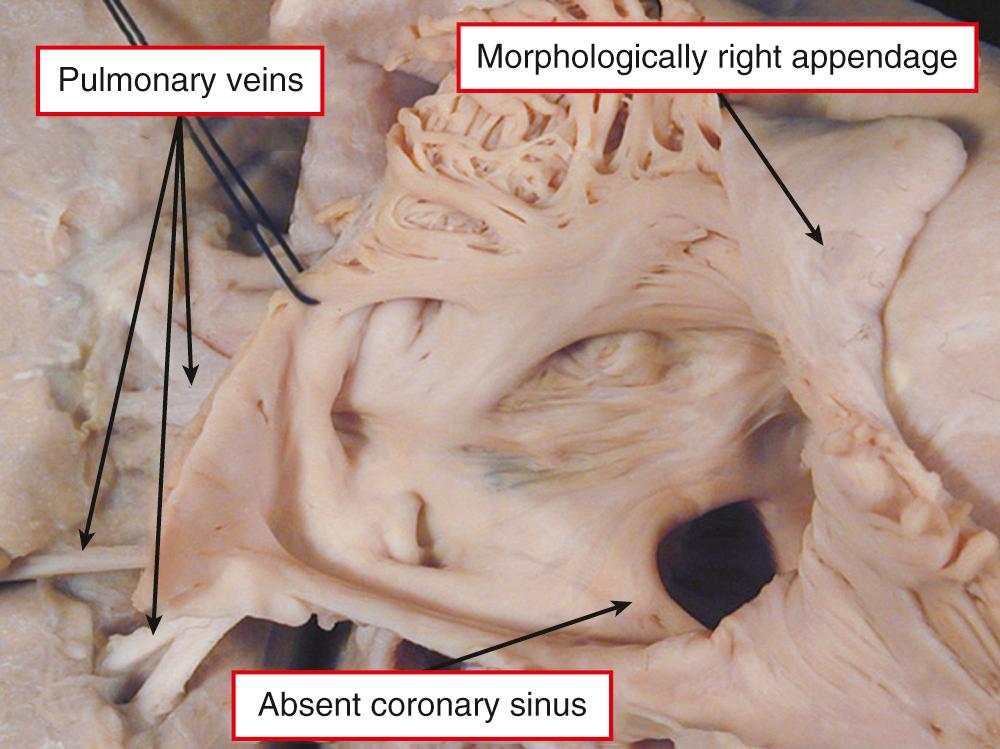
Totally anomalous pulmonary venous connection, along with absence of the coronary sinus, is therefore the distinguishing atrial feature of hearts with isomeric right atrial appendages. In contrast, an anomalous connection of the inferior caval vein usually draws attention to the potential presence of isomeric left atrial appendages. In this setting, there is absence of the suprarenal segment of the inferior caval vein, with the abdominal segment of the caval vein continuing through the azygos venous system ( Fig. 26.14 ) to drain to either the right- or left-sided superior caval vein. In patients with left isomerism, both accessory venous systems are strictly “hemiazygos,” since the hemiazygos vein is a morphologically left structure. It is simpler, nonetheless, to describe communication via the azygos venous system to account for the right-sided or left-sided location of the anomalous venous channel. Azygos continuation can be found in the setting of right isomerism but is very rare. Although the suprarenal segment of the inferior caval vein is absent, a confluent suprahepatic venous channel can be found in up to one-third of the patients with isomeric left atrial appendages.
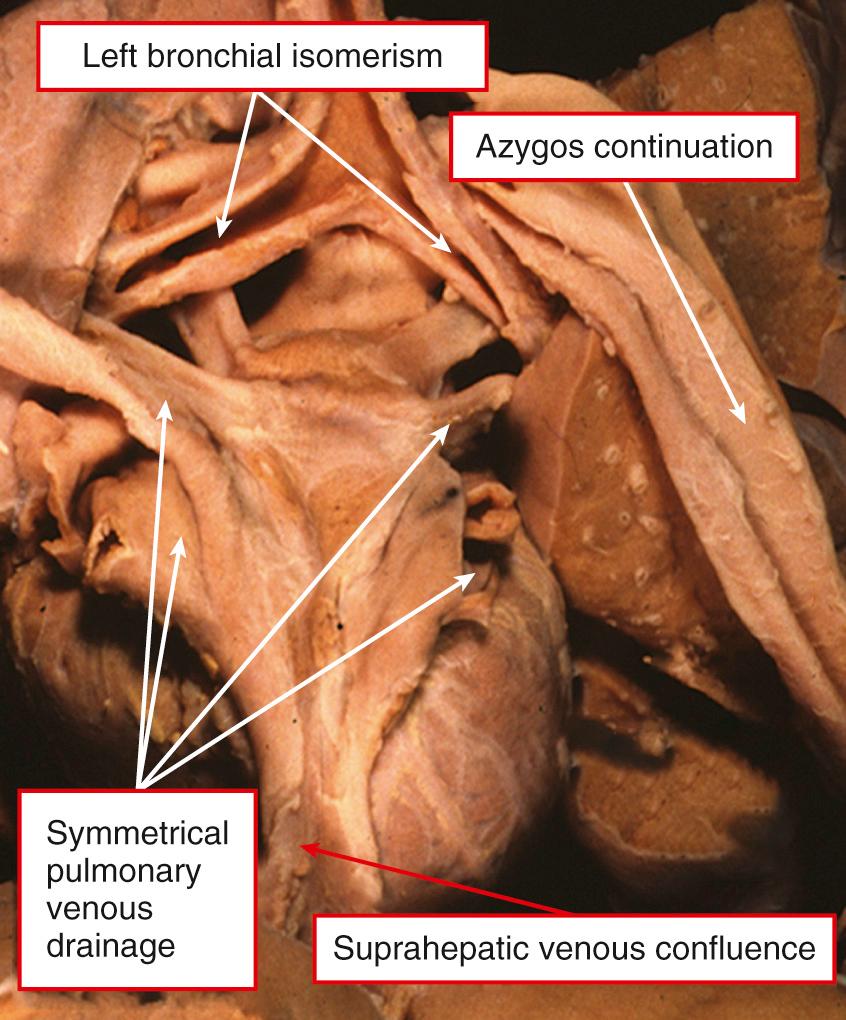
The presence of separate connection of the hepatic veins, when combined with the relationship of the abdominal great vessels relative to the spine, had been considered a reliable means of distinguishing noninvasively the presence of right and left isomerism. We now know this not to be strictly accurate. It is difficult, if not impossible, to distinguish with certainty cases as having isomerism simply by studying the relationships of the abdominal great vessels to the spine. This is not to detract from the value of this feature when used as the initial step in the ultrasonographic assessment of sequential segmental anatomy. Knowledge of the overall connections of the pulmonary veins, the inferior caval vein, and the drainage of the hepatic veins to the atriums, along with the arrangement of the coronary sinus, nonetheless, is a more accurate means of distinguishing between the right and left forms of isomerism. Bilateral connections of superior caval veins to the roofs of the right- and left-sided atriums, however, are frequent in either setting. In those with isomeric left appendages, these connections are anomalous on each side. In those with isomeric right atrial appendages, in contrast, they are anatomically normal, with each caval vein appropriately related to a terminal crest ( Fig. 26.15 ), and with sinus nodes present subepicardially in the bilateral terminal grooves. The drainage of the veins from the heart itself is also abnormal in both right and left isomerism. This is no more than to be expected in right isomerism since, in the universal absence of the coronary sinus, there is no transverse channel within the atrioventricular groove to collect the venous return from the heart. The variability in termination of the individual cardiac veins is surprising. The veins can terminate directly, take a crooked course for a short distance along the atrioventricular groove, or traverse the atrial wall for some distance before draining into the atrium well away from the atrioventricular groove, often adjacent to the opening of a pulmonary or systemic vein ( Fig. 26.16 ). Such direct, crooked, or distant venous terminations are also to be found in hearts with isomeric left appendages, but a coronary sinus receiving all the coronary venous return is more frequent in cases with left isomerism.
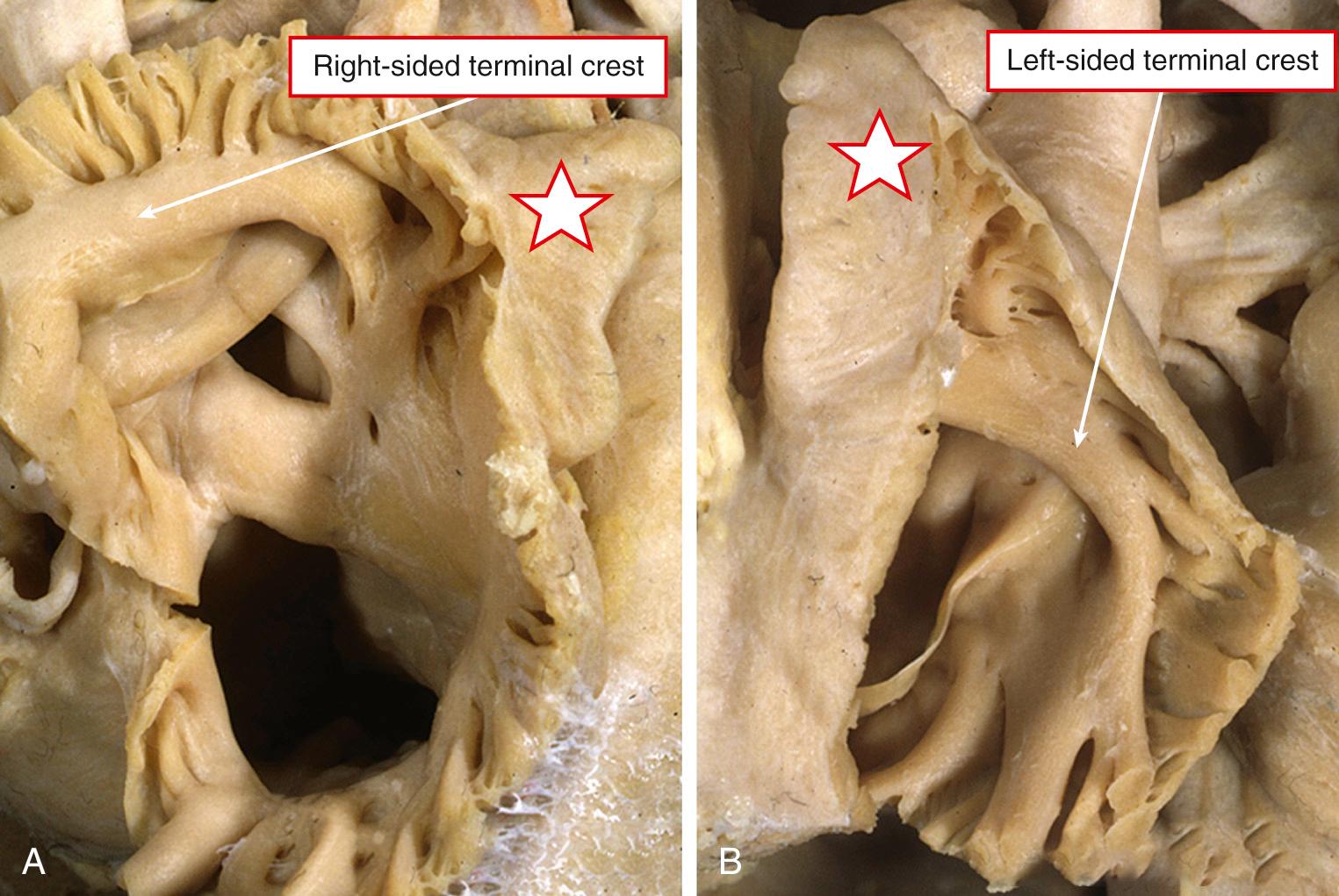
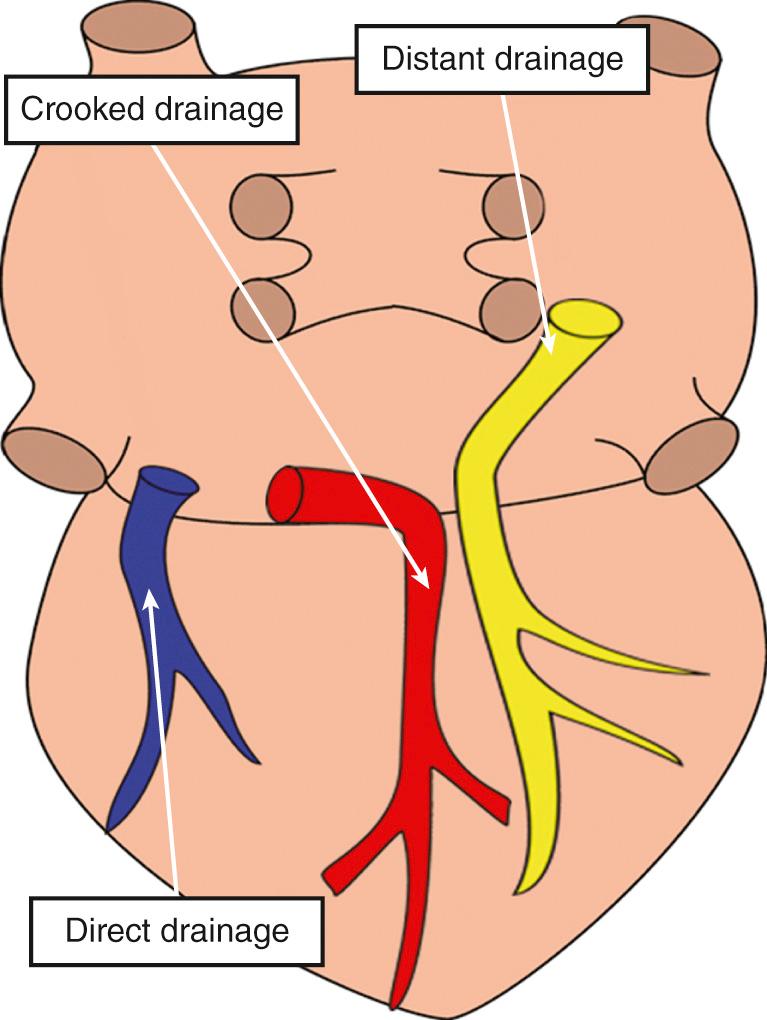
Although the extent of atrial septal deficiency fails positively to discriminate between patients having isomeric right or left atrial appendages, the septum tends to be better formed in those with left isomerism. In those with right atrial appendages bilaterally, most frequently there is simply a strand of atrial tissue that spans a common atrial cavity. It is rare to find the atrial septum completely lacking, but in most cases there is, effectively, a common atrium. In about one-fourth of cases, the septum is well formed superiorly in association with an atrioventricular septal defect, while very rarely the septum can be intact or the oval foramen be probe patent. An effectively common atrium is to be expected in about half of cases with left isomerism. An atrioventricular septal defect is also present in nearly half, while the septum can be virtually intact in nearly one-fifth.
As with hearts in which the atrial appendages are lateralized, chambers with isomeric appendages can each be connected to their own ventricles, or the atriums can be connected to only one ventricle. When the atrioventricular connections are biventricular, it is essential also to describe the ventricular topology. This is because there are two patterns to be found, irrespective of whether the isomeric appendages are of right or left morphology. In the first pattern, the right-sided atrium, whether associated with a morphologically right or left appendage, will be connected to the morphologically right ventricle and the left-sided atrium to the morphologically left ventricle. This ventricular topology is right-handed ( Fig. 26.17 , left ). In the second arrangement, the right-sided atrial chamber, which again may possess either a morphologically right or left atrial appendage, will be connected to a morphologically left ventricle, and the left-sided atrium will be connected to a morphologically right ventricle. In this second pattern, the ventricular topology is left-handed (see Fig. 26.17B , right ). When we initially defined such atrioventricular connections, we described them as ambiguous. We now recognize that it is better to describe them as biventricular and mixed, proceeding always to describe the ventricular topology present and, if necessary, any abnormal and unexpected ventricular relationships. Biventricular and mixed atrioventricular connections are much more frequent in the setting of isomeric left atrial appendages, with most of these patients having right-hand pattern ventricular topology.

Univentricular atrioventricular connections, typically with double inlet via a common atrioventricular valve, are significantly more frequent in hearts with right isomerism. In about one-third of such instances, the univentricular connection will be to a morphologically right ventricle, usually left-sided, but in some it will not be possible to find a second ventricle. The majority of hearts will have double inlet to a dominant morphologically left ventricle, but solitary and indeterminate ventricles are more frequent with isomerism than in any other setting. Absence of the left-sided or right-sided atrioventricular connection is rare but can be found with any ventricular morphology. Thus, when the atrial appendages are isomeric, any type of univentricular atrioventricular connection must be anticipated, along with any possible ventricular morphology. Fewer hearts with left isomerism have univentricular atrioventricular connections, but the same variability must be expected.
Irrespective of the presence of biventricular or univentricular atrioventricular connections, most hearts with right isomerism have a common atrioventricular junction guarded by a common valve (see Fig. 26.4 ). As would be expected, with such a high incidence of atrioventricular septal defects, the ventricular septum in the majority of hearts with biventricular atrioventricular connections is deformed in the anticipated fashion. In the very rare cases with right isomerism but without an atrioventricular septal defect, ventricular septal defects are the rule and can be perimembranous or muscular. In all hearts with univentricular atrioventricular connection, whether a right or left isomerism, those with incomplete ventricles have interventricular communications as anticipated for the ventricular morphology present.
Among the entire group of hearts with isomeric atrial appendages, there is just as much variability in type and mode of ventriculoarterial connection, infundibular morphology, and arterial relationships as encountered in congenital cardiac disease as a whole. Certain patterns occur with significantly different frequencies in hearts with isomeric right as opposed to left appendages. Pulmonary obstruction or atresia is significantly more common in association with right than with left isomerism. When there is pulmonary atresia, the pulmonary supply is almost always duct dependent, although supply through systemic-to-pulmonary collateral arteries can sometimes be found. Obstruction of the left ventricular outflow tract, with aortic coarctation or atresia, is much more common with left isomerism. Analysis of the ventriculoarterial junctions as a whole shows significant differences between the two isomeric arrangements. An anterior right-sided aorta, along with subaortic or bilateral infundibulum, is more common with right isomerism, while concordant ventriculoarterial connections are more frequent in left isomerism.
The morphology of the sinus node reflects the arrangement of the atrial appendages. In right isomerism, there are bilateral sinus nodes, each related to the terminal crest and the cavoatrial junction in normal fashion. In left isomerism, in contrast, there are no terminal crests and no right atrial appendages. The sinus node therefore cannot occupy its normal position. Indeed, in most hearts studied, it has not proved possible to identify with certainty the sinus node. When a candidate for the sinus node is discovered, it tends to be grossly hypoplastic and located in the atrial wall adjacent to the atrioventricular junctions.
The disposition of the atrioventricular conduction axis reflects both the atrioventricular connection present and the ventricular topology. When there are biventricular atrioventricular connections, the dominant feature is the ventricular topology. An atrioventricular node in its regular position, with a posteroinferior penetrating atrioventricular bundle, is found with right-hand topology. When there is left-hand ventricular topology, there is usually an anterior atrioventricular node, and the conduction system is found as is typical for congenitally corrected transposition. Alternatively, a sling of conduction tissue is present running along the crest of the ventricular septum, producing a connection with two atrioventricular nodes. With univentricular atrioventricular connection, ventricular morphology becomes the dominant feature. When the left ventricle is dominant, the atrioventricular node is found in anterior position, with the bundle varying its relationship to the outflow tract of the left ventricle according to the position of the incomplete right ventricle (see Chapter 49 ). With connection to a dominant right ventricle, the conduction system is normally situated when the incomplete left ventricle is left-sided, but an anterior node or sling may be found when the incomplete left ventricle is right-sided. The atrioventricular conduction tissues are bizarre when there is a solitary and indeterminate ventricle.
Become a Clinical Tree membership for Full access and enjoy Unlimited articles
If you are a member. Log in here